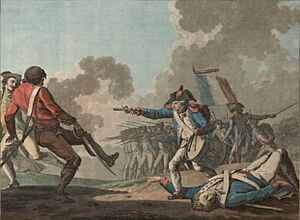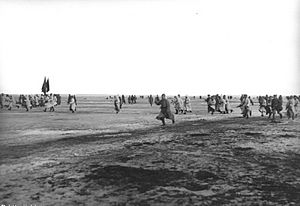Counter-revolutionary facts for kids

A counter-revolutionary is someone who goes against a revolution. This person or group tries to stop a revolution from happening, or they try to undo it after it has already happened. They want to bring back the old ways or the old government that existed before the revolution.
Contents
What is a Counter-Revolution?
A counter-revolution is when people or groups oppose a revolutionary movement. This can mean trying to stop a revolution before it takes power. It can also mean trying to bring back the old system after a revolution has succeeded.
Counter-Revolutions in History
Egypt
After Hosni Mubarak's government was overthrown in the 2011 revolution, some people tried to cause problems to stop the new changes. For example, there were power outages, police sometimes refused to help citizens, and oil was even dumped to stop gas stations from working. These acts were seen as attempts to reverse the revolution.
A big event happened in Egyptian football on February 1, 2012. Seventy-two Al Ahly fans died in the Port Said Stadium riot. Many people believe this riot was planned as revenge against football fans who had joined the 2011 revolution. They also chanted against the government during matches. Police and security forces in the stadium seemed unwilling to stop the riot, which made many think it was a counter-revolutionary act.
Europe
France
The idea of "counter-revolutionary" first came from thinkers who were against the 1789 French Revolution. People like Joseph de Maistre and Louis de Bonald believed in the old ways. Later, Charles Maurras started a movement that wanted to bring back the king.
After the French Revolution, the new government made changes that went against the church and executed King Louis XVI. This led to the Revolt in the Vendee. In 1793, supporters of the king and the Catholic Church fought against the new French Republic. They were angry because the government wanted 300,000 men to join the army. This revolt is sometimes called the first modern genocide by historians. The Vendeans also fought against Napoleon when he tried to make them join his army in 1815.
Germany
The German Empire and earlier German states were based on old-fashioned ideas. They stopped uprisings, like those in 1848. Later, when Germany became a new country in the late 1800s, its leader Otto von Bismarck used some ideas from Socialists, like state-sponsored healthcare. He did this to weaken those who opposed the monarchy and protect it from revolution.
After the German Revolution of 1918–1919, a failed attempt to overthrow the government happened. This was called the Kapp Putsch. It was led by people who were against the new Weimar Republic.
During the Weimar era, Germany was divided between "red" (left-wing) and "white" (conservative) groups. The army and high officials were mostly conservative. Left-wing groups tried to start uprisings. The Nazi Party later joined forces with the conservatives against the communists. This helped the Nazis take over the German state. They used symbols from the old monarchy to make people feel like they were bringing back tradition.
The Nazis did not call themselves "counter-revolutionaries." They even called traditional German groups like monarchists "reactionaries." However, the Nazis did support many of the same ideas as counter-revolutionary groups. They strongly opposed revolutionary Marxism and used groups like the Freikorps to stop communist uprisings. They also praised German traditions and heroes. The Nazis called their rise to power in 1933 the "national revolution." But they also wanted stability and rejected the Weimar Constitution. They linked their new state to the historic German empires, calling it the "Third Realm." This made people who wanted the old ways feel good about the Nazis.
Great Britain
Many historians believe that the rise of Methodism in Great Britain helped prevent a revolution there. John Wesley and his Methodist followers preached the Christian Gospel. They also helped the poor, the sick, and the elderly. They built hospitals and clinics that offered free healthcare. Methodists encouraged people to take control of their lives and follow moral rules. They also practiced temperance (avoiding alcohol) and rejected gambling. This helped them save money and avoid poverty.
People who went to Methodist churches and Sunday schools learned skills and values. They then used these skills in their jobs and in politics to help working-class people in peaceful ways. The Methodist Church helped fill a gap in English society. It offered ways for people to improve their lives and ideas, which helped prevent society from splitting into strict classes. Some argue that Methodism was a different kind of revolution that brought social change without violence.
Italy
After Napoleon's army took over parts of Italy in the late 1700s, there were counter-revolutions. The most famous was the Sanfedismo movement. This group, led by Cardinal Fabrizio Ruffo, overthrew the new French-backed government. They brought back the old Bourbon royal family to the throne of Naples. Another similar event happened when Napoleon returned to Italy later.
After Italy became one unified country, peasants in Southern Italy rebelled. The old Bourbon government, which was in exile, and the Papal States encouraged this revolt. This rebellion was called "brigandage" by its opponents. It led to a bloody civil war that lasted almost ten years.
Austria
In the Austrian Empire, there was a revolt against Napoleon in 1809 called the Tyrolean Rebellion. Andreas Hofer, an innkeeper from Tyrol, led 20,000 rebels. They successfully fought against Napoleon's troops. However, Hofer was later betrayed and captured. He was executed in 1810.
Spain
The Spanish Civil War was a counter-revolution. In 1936, supporters of Carlism (a movement that wanted a specific royal family), the monarchy, and nationalism (like the Falange) joined forces. They fought against the (Second) Spanish Republic. These counter-revolutionaries believed the Spanish Constitution of 1931 went against Spanish culture, traditions, and religion.
On the other side, some actions by the Communist Party of Spain against farming communities are also sometimes seen as counter-revolutionary. The Carlist cause, which began in 1833, still exists today.
Russia
The White Army and its supporters tried to defeat the Bolsheviks after the October Revolution. They were counter-revolutionaries. Also, in Germany, police, soldiers, and groups like the Freikorps crushed the German Revolution of 1918–1919. They were also counter-revolutionaries. The Bolshevik government tried to make peasant rebels, known as the Green armies, seem like anti-revolutionaries. The largest peasant rebellion against Bolshevik rule happened in Tambov in 1920–21.
Hispanic America
Mexico
In the 1910s, General Victoriano Huerta and later the Felicistas tried to stop the Mexican Revolution. In the late 1920s, Mexican Catholics fought against the Mexican Federal Government in the Cristero War. President Plutarco Elias Calles, elected in 1924, started policies against Catholics. This led to peaceful resistance from Catholics in 1926. The counter-revolution began as a peaceful movement. But in the summer of 1926, fighting broke out. The fighters, called Cristeros, fought the government because it was suppressing the Church, jailing priests, and promoting anti-Catholic ideas.
Cuba, Nicaragua, and Colombia
The 1961 Bay of Pigs invasion into Cuba was carried out by counter-revolutionaries. They hoped to overthrow the revolutionary government of Fidel Castro. In the 1980s, the Contra-Revolución rebels fought to overthrow the revolutionary Sandinista government in Nicaragua. They were called "Contras" because they were counter-revolutionaries.
The Black Eagles, the AUC, and other paramilitary groups in Colombia can also be seen as counter-revolutionary. These right-wing groups oppose the FARC and other left-wing guerrilla movements.
Sometimes, counter-revolutionaries are people who were once revolutionaries themselves. They supported the first overthrow of the old government but later disagreed with those who took power. For example, some of the Contras first fought with the Sandinistas to overthrow Anastasio Somoza. Also, some people who opposed Castro had also opposed Batista.
Asia
Japan
During the Bakumatsu period in the mid-1800s, especially during the Boshin War (a Japanese civil war from 1868 to 1869), forces loyal to the old government fought against change. These were mainly samurai who had lost their jobs and money. They joined the shogun, Tokugawa Yoshinobu, who wanted to keep foreign influence out of Japan. They fought against the revolutionaries of Emperor Meiji, who wanted to modernize Japan like Western countries. The war ended with few deaths, mostly samurai. Years later, another deadly rebellion, the Satsuma Rebellion, happened.
China
In 1917, during the Warlord Era, a general named Zhang Xun tried to undo the 1911 Revolution. That revolution had ended the Qing dynasty. Zhang Xun tried to bring back the emperor by taking over Beijing in what was called the Manchu Restoration.
The anti-communist Kuomintang party in China used the term "counter-revolutionary" to criticize communists and other opponents. Chiang Kai-shek, the Kuomintang leader, often used this term.
The Kuomintang, even though it was conservative, had some revolutionary ideas from its early days. Chiang Kai-shek used words like "feudal" and "counter-revolutionary" to mean bad or old-fashioned. He proudly called his own party "revolutionary." Chiang called warlords "feudalists" and said they needed to be stopped. He got very angry if someone called him a warlord.
Chiang also took control of rich merchants in Shanghai in 1927. He forced them to give loans to the Kuomintang, threatening them with death or exile. He arrested wealthy people, accusing them of being "counter-revolutionary." He held them until they gave money to his party. Chiang also enforced a boycott against Japanese goods. His agents would raid shops selling Japanese items and fine them.
In the People's Republic of China, a similar term exists. It includes charges like working with foreign groups or starting revolts against the government and the ruling CCP. The Chinese constitution says the state will stop "counter-revolutionary activities."
This term was used a lot during the Cultural Revolution. Thousands of smart people and government officials were called "counter-revolutionaries" by the Red Guards. After the Cultural Revolution ended, the term was also used for Lin Biao and the Gang of Four.
How the Term is Used
The word counter-revolutionary is often used like reactionary. However, "reactionary" usually describes someone who opposes a long-term social change. "Counter-revolutionary" describes someone who opposes a very recent and sudden change.
Sometimes it's hard to tell who is the revolutionary and who is the counter-revolutionary. After the Iranian Revolution, the religious leaders who took power became counter-revolutionaries to the Marxists, who were driven out. Thousands of political prisoners who opposed the new religious government were killed, especially in 1988.
In Hungary, the 1956 uprising was called a counter-revolution by the ruling Communist government. They claimed to be revolutionary themselves. But thirty years later, after the Communist government fell, the events of 1956 were more widely known as a revolution. This meant it was a rebellion against authority, not a statement about its ideas.
|
See also
 In Spanish: Contrarrevolución para niños
In Spanish: Contrarrevolución para niños


